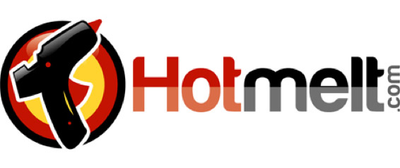Introduction to Adhesive Dots
Hot melt adhesive dots are one of the most useful adhesive products on the market. Glue dots—often called glue “spots”—are small, round dabs of pressure-sensitive hot melt. They are applied to a coated surface so they can be easily removed and applied to a variety of substrates. Because they have an instant bond, glue dots eliminate dangerous odors, the mess associated with liquid hot melt adhesives, and residue left behind from film, tape, and webbing.
However, they still maintain the same flexibility of hot melt with applications ranging from production lines to mailing materials. At Hotmelt, we carry several brands of glue dots with varying levels of strength and stickiness so you can always find what you need for your project. These are the six biggest mistakes to avoid when using your glue spots to ensure you get the application you expect.
1. Adhering to Dirty Surfaces
To get the best bond possible, your substrates must be cleaned of any moisture, oil, dust, or other particles. Make sure everything you’re attaching your dots to is clean and dry.
2. Using the Wrong Size Dot
It might seem like the size of your glue dot is simply a matter of preference, but it takes more consideration than that. Your choice should depend on the size of the surface area you’re bonding. There is a correlation between the amount of surface contact and the strength of the bond. Therefore, the choice between using a ¾ inch dot or a ½ inch dot should depend on more than just your opinion. In addition to ensuring your bond is strong, choosing the right-sized hot melt adhesive dots ensures you’ll be able to appropriately space them so that your budget is spent more efficiently.
3. Applying Dots in Harsh Environments
Extreme heat, freezing cold, and wetness all put a lot of stress on adhesives. Glue dots are especially susceptible to failure in these harsh environments since they’re applied in a hardened state instead of having a chance to bond after application through processes like heating and drying. If the substances you’re bonding will be exposed to a harsh environment or the failure of your application will be catastrophic, you may want to consider a more secure hot melt solution.

4. Keeping Your Glue Dots on the Shelf Too Long
Hot melt adhesive dots don’t break down over time. However, since they’re already in their final, sticky state instead of a container or a hardened pre-melted form, they can more easily be contaminated with moisture and dust. To ensure a lasting bond, we recommend replacing unused glue dots after 18 months and always keeping them in the cleanest, driest place possible.
5. Choosing the Wrong Profile
“Profile” is the vertical thickness of your glue dot. A lower profile will be thinner or flatter, while a higher profile will have more depth. Low profile dots work great for very smooth, flat substrates that already fit snugly together before any adhesive is applied. Thicker, higher-profile dots are great for concave surfaces, which have curves, or that are otherwise irregularly shaped.
6. Choosing the Wrong Tack
Tack, which is a way to describe just how sticky something is, is vital to get right when it comes to hot melt adhesive dots. Tack measurements start at low, where the adhesive is considered removable. Tacks levels increase until they get to super-high tack, where the bond is considered permanent.
For an application like something you would want on a credit card mailer, a low tack, low profile glue spot would work best because the bond is removable. For a more permanent bond, used on items like electronics and appliances a super-high tack, low profile glue spot is usually the best option.

Questions? We Are Here to Help
Making size, tack, and profile decisions can be challenging but is an important part of achieving your desired results. If you need assistance choosing the right product or want more tips on how to get the best results from your glue spots, contact us. Our knowledgeable team members are happy to assist you.

